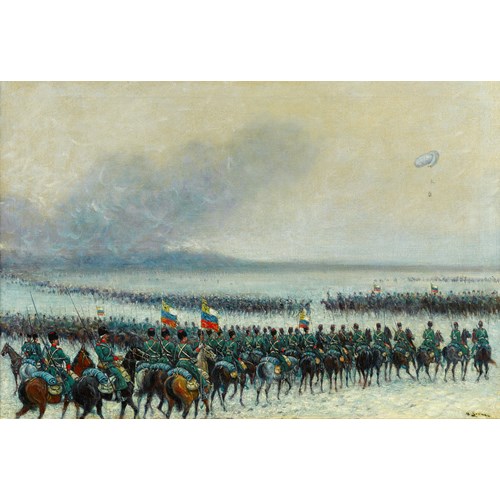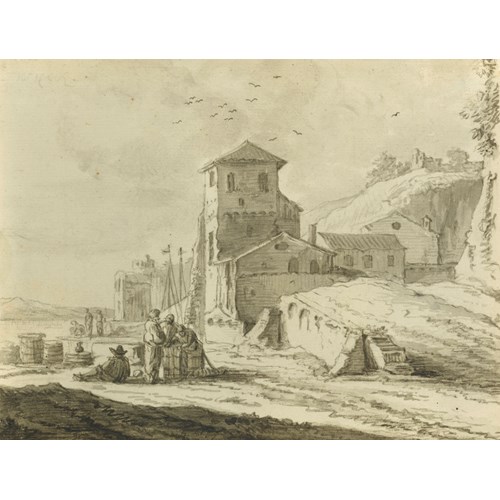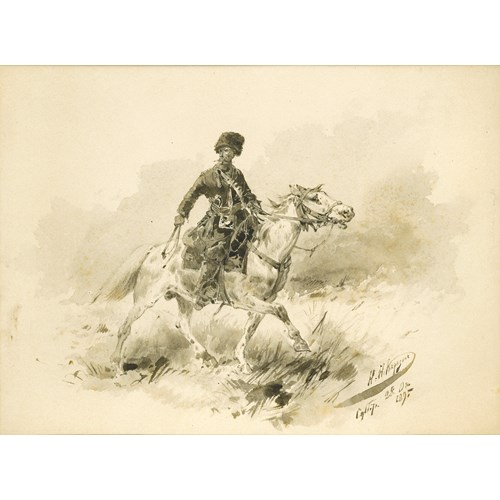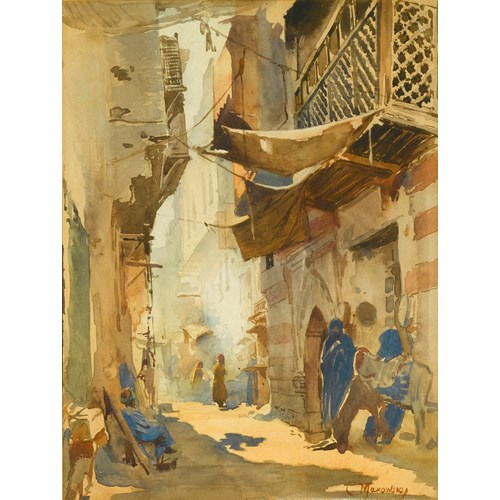Marketplace
Two Men, One Elaborately Dressed, before a Fireplace, a Woman in a Kitchen Beyond (Recto); A Woman Bending forwards in Work, and a Dancing Putto (Verso)
Cornelis de Man
Two Men, One Elaborately Dressed, before a Fireplace, a Woman in a Kitchen Beyond (Recto); A Woman Bending forwards in Work, and a Dancing Putto (Verso)
Period 1600-1750, 17th century
Origin The Netherlands
Medium Pen, Brown ink, Black chalk (recto), Black lead (verso)
Dimension 13.2 x 17.7 cm (5¹/₄ x 7 inches)
This distinctive and animated drawing is attributed to Cornelis de Man, on the basis of its stylistic and thematic similarities with paintings by the artist, whose drawings are rare. Although he sometimes painted Italianate landscapes and church architecture, de Man is best known for his depictions of middle-class Dutch domestic interiors, for which he took inspiration from Jan Vermeer (1632-1675) and Pieter de Hooch (1629-1684). One of his most celebrated paintings, Man Weighing Gold, depicts, like the present composition, a man wearing an ornate cap. The man’s exotic appearance in both works is most striking in that it contrasts with the ordinary domesticity of his surroundings, a visual juxtaposition that is typical of de Man’s paintings.
Two Men, One Elaborately Dressed, before a Fireplace, a Woman in a Kitchen beyond was purchased by the previous owner as an illustration of the story of ‘Jacob and Joseph’, although it is unclear what biblical episode it is thought to depict. In the corner of a humble Dutch home, two men are seated on low chairs warming their feet at the hearth. One, the elder of the two, and perhaps therefore representing Jacob, learns forward holding a ladle to taste the contents of the pot suspended over the flames. He wears a simple doublet and breeches with a brimmed hat. His companion, seated with his back turned to us, wears a more elaborate costume and a conspicuously decorative hat that gives him a foreign and mysterious air. His dress could be explained by his identity as Joseph; perhaps he is wearing the legendary robe that Jacob made for him.
Framing the two figures is the large mantelpiece of the fireplace; behind is a window and to the right a doorway, through which a woman can be seen attending to her household chores. The multitude of differing angles used to represent the furnishings and proportions of the room, typical features within de Man’s work, displays an expert understanding of perspective. The hasty, energetic pen and ink strokes give the drawing a liveliness that is particularly evident in the curlicues of smoke spiralling up towards the chimney and the dashes used to indicate the facial features and clothing of the figures.
Little is known about the details of de Man’s life. Now a celebrated artist, he was almost forgotten until 1903, when the art historian Hofstede de Groot (c.1863-1930) rediscovered his work. De Man may have come from a family of jewellers and he certainly had relatives in the clergy, which would have given him an elevated social rank. In 1642, he entered the Delft Guild of St. Luke. Subsequently, he worked in Paris, Florence, Rome and Venice, before returning to Delft in 1654 and settling there. At the age of thirty-six, he was appointed regent of the guild, a position that he held repeatedly through the years, suggesting that he was a person of notable stature in the artistic community.
Two Men, One Elaborately Dressed, before a Fireplace, a Woman in a Kitchen beyond was purchased by the previous owner as an illustration of the story of ‘Jacob and Joseph’, although it is unclear what biblical episode it is thought to depict. In the corner of a humble Dutch home, two men are seated on low chairs warming their feet at the hearth. One, the elder of the two, and perhaps therefore representing Jacob, learns forward holding a ladle to taste the contents of the pot suspended over the flames. He wears a simple doublet and breeches with a brimmed hat. His companion, seated with his back turned to us, wears a more elaborate costume and a conspicuously decorative hat that gives him a foreign and mysterious air. His dress could be explained by his identity as Joseph; perhaps he is wearing the legendary robe that Jacob made for him.
Framing the two figures is the large mantelpiece of the fireplace; behind is a window and to the right a doorway, through which a woman can be seen attending to her household chores. The multitude of differing angles used to represent the furnishings and proportions of the room, typical features within de Man’s work, displays an expert understanding of perspective. The hasty, energetic pen and ink strokes give the drawing a liveliness that is particularly evident in the curlicues of smoke spiralling up towards the chimney and the dashes used to indicate the facial features and clothing of the figures.
Little is known about the details of de Man’s life. Now a celebrated artist, he was almost forgotten until 1903, when the art historian Hofstede de Groot (c.1863-1930) rediscovered his work. De Man may have come from a family of jewellers and he certainly had relatives in the clergy, which would have given him an elevated social rank. In 1642, he entered the Delft Guild of St. Luke. Subsequently, he worked in Paris, Florence, Rome and Venice, before returning to Delft in 1654 and settling there. At the age of thirty-six, he was appointed regent of the guild, a position that he held repeatedly through the years, suggesting that he was a person of notable stature in the artistic community.
Period: 1600-1750, 17th century
Origin: The Netherlands
Medium: Pen, Brown ink, Black chalk (recto), Black lead (verso)
Dimension: 13.2 x 17.7 cm (5¹/₄ x 7 inches)
Provenance: Count M. von Fries (L.2903);
Jacobus A. Klaver, Amsterdam
More artworks from the Gallery


 A Woman Bending forwards in Work, and_T638856835938571470.jpg?width=2000&height=2000&mode=max&scale=both&qlt=90)






